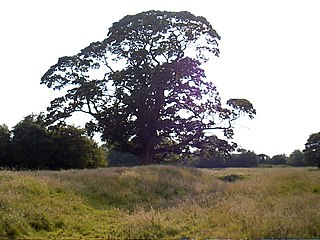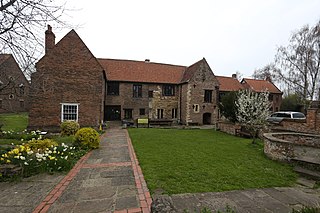
Wharfedale is the valley of the upper parts of the River Wharfe and one of the Yorkshire Dales. It is situated in North Yorkshire, and the cities of Leeds and Bradford in West Yorkshire. It is the upper valley of the River Wharfe. Towns and villages in Wharfedale include Buckden, Kettlewell, Conistone, Grassington, Hebden, Bolton Abbey, Addingham, Ilkley, Burley-in-Wharfedale, Otley, Pool-in-Wharfedale, Arthington, Collingham and Wetherby. Beyond Wetherby, the valley opens out and becomes part of the Vale of York.

The Abbey of St Mary is a ruined Benedictine abbey in York, England and a scheduled monument.

Meaux Abbey was a Cistercian abbey founded in 1151 by William le Gros, 1st Earl of Albemarle, Earl of York and 4th Lord of Holderness, near Beverley in the East Riding of Yorkshire, England.

Cottingham is a large village and civil parish in the East Riding of Yorkshire, England. It lies 4 miles (6 km) north-west of the centre of Kingston upon Hull, and 6 miles (10 km) south-east of Beverley on the eastern edge of the Yorkshire Wolds. It forms part of Hull's Urban Area. It has two main shopping streets, Hallgate and King Street, which cross each other near the Church of Saint Mary the Virgin, and a market square called Market Green. Cottingham had a population of 17,164 residents in 2011, making it larger by area and population than many towns. As a result, it is one of the villages claiming to be the largest village in England.

Bradway Tunnel, 1 mile 266 yards (1.853 km) long, was built in 1870 about 1-mile (1.6 km) north of Dronfield, Derbyshire, in South Yorkshire, England.

Hull Paragon Interchange is a transport interchange providing rail, bus and coach services located in the city centre of Kingston upon Hull, England. The G. T. Andrews-designed station was originally named Paragon Station, and together with the adjoining Station Hotel, it opened in 1847 as the new Hull terminus for the growing traffic of the York and North Midland (Y&NMR) leased to the Hull and Selby Railway (H&S). As well as trains to the west, the station was the terminus of the Y&NMR and H&S railway's Hull to Scarborough Line. From the 1860s the station also became the terminus of the Hull and Holderness and Hull and Hornsea railways.
Chester Carmelite Friary, otherwise Chester Whitefriars, was a friary in the city of Chester in Cheshire, England. The Carmelites were present in Chester from the late 1270s and by the mid-14th century were established as a well-regarded community. Their church and graveyard were popular for burials of the well-to-do and the friary was often mentioned in Chester wills. Their church steeple when rebuilt in 1495 became a useful landmark for ships. The friary was dissolved in 1538. There are no surviving buildings but the street name Whitefriars preserves the memory of the community.
Greyfriars, Beverley was a Franciscan friary in Beverley, the East Riding of Yorkshire, England. It was established before 1267, probably by John de Hightmede, but the exact date is not known. Originally located within the town walls near today's St Mary's Terrace, it was moved outside Keldgate, near Westwood, about 1297. After it had fallen into disrepair in the 1330s, the knight Sir John Hotham of Scorbrough provided funds for its rebuilding in the 1350s. Several members of his family were buried there later. The friary benefitted further from grants made by nobles and merchants. The friars acknowledged royal supremacy in 1534, and the monastery was surrendered to the Bishop of Dover on 25 February 1538–39. Although no buildings of the friary have survived, it is remembered by the street name "Greyfriars Crescent".
Ellerton Priory was a Gilbertine priory that was historically in the East Riding of Yorkshire, England. The ruins stand in the village of Ellerton, on Spalding Moor in the East Riding of Yorkshire. The priory was founded no later than 1207, during the reign of King John, by Peter de Goodmanham.

Healaugh Park Priory was an Augustinian priory in Healaugh, North Yorkshire, England, some 2 miles (3 km) north of Tadcaster.

York Carmelite Friary was a friary in York, North Yorkshire, England, that was established in about 1250, moved to its permanent site in 1295 and was surrendered in 1538.
Copmanthorpe Preceptory was a medieval monastic house in North Yorkshire, England.
Augustinian Friary, York was a friary in North Yorkshire, England.
St Richard's Friary, also known as Pontefract Friary, was a Dominican friary in Pontefract, West Yorkshire, England. It was located near today's Pontefract General Infirmary, on the eastern edge of Friarwood Valley Gardens.
Tickhill Friary was an Augustinian friary in Tickhill, South Yorkshire, England. John Clarel, a canon of Southwell, founded it about 1260. It was dissolved in 1530. The remains are a Grade II* listed monument. The 14th century buildings were converted into dwellings in the 17th century, extensions followed in the 19th century. Until 1538, the Fitzwilliam tomb was located in the friary church, but was then moved into the parish church.

In London, the Greyfriars was a Conventual Franciscan friary that existed from 1225 to 1538 on a site at the North-West of the City of London by Newgate in the parish of St Nicholas in the Shambles. It was the second Franciscan religious house to be founded in the country. The establishment included a conventual church that was one of the largest in London; a studium or regional university; and an extensive library of logical and theological texts. It was an important intellectual centre in the early fourteenth century, rivalled only by Oxford University in status. Members of the community at that time included William of Ockham, Walter Chatton and Adam Wodeham. It flourished in the fourteenth and fifteenth century but was dissolved in 1538 at the instigation of Henry VIII as part of the Dissolution of the Monasteries. Christ's Hospital was founded in the old conventual buildings, and the church was rebuilt completely by Sir Christopher Wren as Christ Church Greyfriars after the original church was almost completely destroyed in the Great Fire of London of 1666. The building now standing on the site, designed by Arup Group Limited, is currently occupied by Merrill Lynch.

St Mary and St Nicholas Church, Beaumaris, an Anglican church, is a fourteenth century Grade I listed building in Beaumaris, Anglesey, Wales.

Beverley Friary is a row of buildings in Beverley, East Riding of Yorkshire, England. The buildings are a Grade II* listed building that since 1984 have been used as a youth hostel. They are thought to be either part of an old Dominican friary, or to have been built on the site of the friary using stone from the site.











